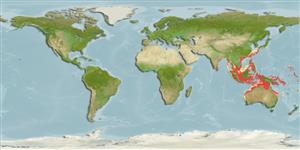Teleostei (teleosts) >
Anguilliformes (Eels and morays) >
Ophichthidae (Snake eels) > Ophichthinae
Etymology: Ophichthus: Greek, ophis = serpent + Greek, ichthys = fish (Ref. 45335).
More on author: Bleeker.
Environment: milieu / climate zone / depth range / distribution range
Ecology
Marine; brackish; demersal; depth range 5 - 20 m (Ref. 133101). Tropical
West Pacific: restricted to the southwestern part of the South China Sea extending to the western coast of the Malay Peninsula.
Size / Weight / Age
Maturity: Lm ? range ? - ? cm
Max length : 95.0 cm TL male/unsexed; (Ref. 12693)
Short description
Identification keys | Morphology | Morphometrics
Vertebrae: 195 - 199. This species is distinguished by the following set of characters: body with numerous longitudinal wrinkles, with more than five longitudinal wrinkles on the posterior part of eye; head length 5.7-7.2% TL; tail length 65.7-67.5% TL; with two protrusions along the upper lip (rarely 1 on one side); dorsal-fin origin behind pectoral-fin tip by less than one pectoral-fin length; SO 1 + 3; POM 4-6 (usually 5) + 2; teeth on maxilla uniserial initially, becoming biserial posteriorly; vomerine and dentary teeth are biserial anteriorly, uniserial posteriorly; total vertebrae 195-199, MVF 15-63-197 (n = 9). Colouration: body bicolored; dorsal fin dark with a narrow margin entirely, anal fin pale except ending (Ref. 133101)
Cross section: circular.
Found in shallow water (Ref. 40865), collected adjacent to a river mouth (Ref. 133101). Probably spends most of the day in a burrow along the river bank and forages actively at night for small fishes (Ref. 12693); in soft bottom (Ref. 7300).
Life cycle and mating behavior
Maturity | Reproduction | Spawning | Eggs | Fecundity | Larvae
Vo, Q.V., Y. Hibino, H.-C. Ho, T.T.T. Le and Y.G. Seah, 2025. Two new snake eels (Anguilliformes, Ophichthidae, Ophichthus) from Viet Nam, with redescriptions of O. macrochir (Bleeker) and O. rutidoderma (Bleeker). ZooKeys 1231:311-329. (Ref. 133101)
IUCN Red List Status (Ref. 130435: Version 2025-1)
Threat to humans
Harmless
Human uses
Fisheries: of no interest
Tools
Special reports
Download XML
Internet sources
Estimates based on models
Preferred temperature (Ref.
123201): 24.2 - 29, mean 28 °C (based on 716 cells).
Phylogenetic diversity index (Ref.
82804): PD
50 = 0.5000 [Uniqueness, from 0.5 = low to 2.0 = high].
Bayesian length-weight: a=0.00091 (0.00039 - 0.00215), b=2.99 (2.79 - 3.19), in cm total length, based on LWR estimates for this (Sub)family-body shape (Ref.
93245).
Trophic level (Ref.
69278): 4.5 ±0.80 se; based on food items.
Resilience (Ref.
120179): Medium, minimum population doubling time 1.4 - 4.4 years (Preliminary K or Fecundity.).
Fishing Vulnerability (Ref.
59153): High vulnerability (58 of 100).
🛈
